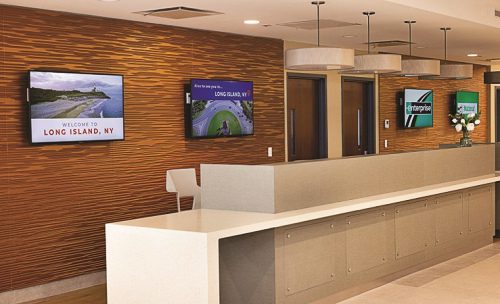The new Ground Transportation Center that opened this spring at Long Island MacArthur Airport (ISP) in Islip, NY, combines facilities for rental car agencies with space for local buses, hotel courtesy shuttles and private vehicles working through Uber, Lyft and other app-based ride-hailing services.
The new Ground Transportation Center that opened this spring at Long Island MacArthur Airport (ISP) in Islip, NY, combines facilities for rental car agencies with space for local buses, hotel courtesy shuttles and private vehicles working through Uber, Lyft and other app-based ride-hailing services.
 “It offers travelers convenience, but it’s really about ‘everything transportation,’” says Airport Commissioner Shelley LaRose-Arken.
“It offers travelers convenience, but it’s really about ‘everything transportation,’” says Airport Commissioner Shelley LaRose-Arken.
In fact, the new facility is an example of larger, significant service and transportation improvements—including greater consolidation of road, air and rail traffic—in and near the airport. LaRose-Arken and other officials note that the Ground Transportation Center builds upon ISP’s other strategic advantages. The airport is located in the Ronkonkoma section of Islip, just 60 miles east of New York City, but smaller and more convenient for passengers than other airports in the New York metropolitan area, she explains.
|
Project: Ground Transportation Center Location: Long Island MacArthur Airport— Islip, NY Annual Enplanements: 800,000 (in pre-pandemic 2019) Scheduled Carriers: American; Breeze Airways; Frontier; Southwest Size of New Transportation Center: 12,000 sq. ft. Construction: Oct. 2020-March 2021 Cost: $8.4 million Funding: New York State Aviation & Economic Development grants; rental car Customer Facility Charges; bonds Tenants: Avis; Budget; Enterprise; National; Autoplane
Architectural & Engineering Design:
Engineering Construction Administration General Contractor: J Anthony Enterprises Electrical Contractor: Rolands Electric Mechanical Contractor: Premier Mechanical Systems Plumbing Contractor: Maccarone Plumbing
Pathogen-Reduction System: iWave-C, |
Clearly, the Ground Transportation Center is a point of pride at ISP. Housed in a former FAA automated flight service station that closed about 15 years ago, the single-story facility is located about 250 feet from the terminal. The completely renovated building includes 12,000 square feet of interior space, plus a 369-space rental car lot right beside it.
The project’s groundbreaking ceremony in October 2020 attracted a range of state and local officials, including Kathy Hochul, New York’s current governor who was lieutenant governor at the time. Speakers at the event noted that ISP generates roughly $600 million in annual economic activity throughout the region, and projects like the new Ground Transportation Center spur additional economic growth.
The airport officially debuted the new facility in April 2022, after a soft opening the month before.
With rental car operations relocated to the Ground Transport Center, new opportunities are in play for the airport. Space in the terminal formerly used for rental car operations will soon house upgraded mechanical, electrical and plumbing systems. That work is expected to be completed this year, notes Rob Schneider, deputy commissioner of Aviation.
The updated building systems will complement and support other terminal improvements currently underway, such as new baggage-claim units and vestibule doors. Looking further ahead, there are plans for more ticket counters and airline offices as the airport secures additional commercial service. Current projects and future plans may prove timely. An additional carrier, Breeze Airways, started service at ISP this February, joining the airport’s other three airlines: American, Frontier and Southwest. The airport also supports general aviation operations, consisting of 300 based aircraft and 105,175 general aviation operations last year.
Extensive Scope
With traffic related to rental car operations shifting from the terminal area to the new Ground Transportation Center, ISP resurfaced portions of airport roadway and parking lots. The new traffic
flows decrease congestion on the terminal frontage road, notes LaRose-Arken.
 As for the Ground Transportation Center itself, it took a lot of work to transform a moribund building into a modern facility for airport passengers. Crews demolished and rebuilt the entire interior of the structure. Despite the extensive renovations that were needed, the project team preferred that strategy to constructing a new building. “Repurposing underutilized facilities that already existed on the property enabled the airport to meet their growth and expansion goals without undertaking a major new construction project,” says Mahesh Kukata, the JKL Engineering principal and vice president who served as construction manager for the Ground Transportation Center project.
As for the Ground Transportation Center itself, it took a lot of work to transform a moribund building into a modern facility for airport passengers. Crews demolished and rebuilt the entire interior of the structure. Despite the extensive renovations that were needed, the project team preferred that strategy to constructing a new building. “Repurposing underutilized facilities that already existed on the property enabled the airport to meet their growth and expansion goals without undertaking a major new construction project,” says Mahesh Kukata, the JKL Engineering principal and vice president who served as construction manager for the Ground Transportation Center project.
To turn the newly empty shell into a customer-oriented transportation hub, the airport had crews install new walls, ceilings, floors, energy-efficient lighting and mechanical systems, information technology/communications infrastructure and a backup generator. The new facility also includes perks added specifically for travelers, such as free high-speed Wi-Fi connectivity, a pathogen-reduction system to enhance indoor air quality, and real-time displays of schedules for courtesy shuttles and Long Island Rail Road service.
Technology and Aesthetics
In light of the devastating COVID-19 pandemic, ISP is particularly proud of the built-in pathogen-reduction system, which cleans air and surfaces inside the Ground Transportation Center. Airport officials were pleased with the performance of Continuous Air Surface Pathogen Reduction equipment installed in the terminal two years ago, and they wanted the same protections for the new facility.
LaRose-Arken reports that ISP was the first airport in the United States to install a Continuous Air and Surface Pathogen Reduction system. It’s the same type of equipment used in hospitals and other medical facilities, she adds.
The system installed in the Ground Transportation Center—iWave-C, from Nu-Calgon—cleans and sanitizes air and surfaces in part by removing moisture from ambient air and treating indoor areas with hydrogen peroxide. Schneider describes it as a commercial air cleaner installed inside the facility’s air ducts.
 “It is a bi-polar ionization generator for actively treating the building’s air quality,” he elaborates. “As air flows past the iWave-C, the device emits positive and negative ions, creating a plasma region that actively purifies the supply air, killing mold, bacteria and viruses in the coil and space. The ionization process also reduces allergens, smoke and static electricity, as well as controlling odors from pets, volatile organic compounds and other particles in the air without creating ozone or any harmful byproducts.”
“It is a bi-polar ionization generator for actively treating the building’s air quality,” he elaborates. “As air flows past the iWave-C, the device emits positive and negative ions, creating a plasma region that actively purifies the supply air, killing mold, bacteria and viruses in the coil and space. The ionization process also reduces allergens, smoke and static electricity, as well as controlling odors from pets, volatile organic compounds and other particles in the air without creating ozone or any harmful byproducts.”
While the pathogen-reduction system works behind the scenes, other features at the Ground Transportation Center are more conspicuous to customers. The building was designed to be attractive as well as convenient. A canopy that is scheduled to be in place this autumn will protect travelers as they make the short trek from the terminal to the new facility. Once inside, customers proceed to a large central space with rental car counters on two sides. Beyond the counters is a lounge area with ample seating. Offices and mechanical rooms are tucked away on three sides of the perimeter. Furniture, wall coverings, and flooring have light brown finishes to suggest the sandy beaches and natural landscapes of the local Long Island area.
LaRose-Arken credits the project team for its resourcefulness and flexibility when pandemic-related supply chain issues made some interior components difficult or impossible to procure. When faced with a shortage of lighting fixtures, the team repurposed and refitted units salvaged from terminal facilities. When the wall coverings originally selected by project designers could not be found, they switched to readily available alternatives. The previously mentioned canopy was originally scheduled to be up this June, but supply chain issues have delayed it a few months.
Ambitious Agenda
The new Ground Transportation Center and pending terminal improvements are telling changes among several others. ISP’s list of capital projects has been long in recent years, totaling about $65 million. Major highlights include:
• $16 million of improvements to the main runway in 2018 (new asphalt, lighting, etc.);
• a new $13.5 million aircraft rescue and firefighting facility completed in 2018;
• $9 million of reconstruction work on the West Terminal Apron in 2020;
• rehabilitation of Taxiway E/F ($7 million) and Taxiway S ($3 million) in 2020 to 2021; and
• the $8.5 million rehabilitation of Runway 15R-33L in 2021.
Amid the other improvement projects, the Ground Transportation Center is still noteworthy. “This is the first project we’ve had in 20 years to improve passenger facilities, so it’s fairly significant,” explains LaRose-Arken. “There will be a follow-up to this in which we will be improving the terminal building as well in 2022.”

Looking ahead, ISP has several major long-term initiatives in the works. LaRose-Arken reports that personnel at the airport and the consultant firm Landrum and Brown are conducting a study about a decades-old concept to relocate the terminal building to the north end of the airport. Connectivity is the impetus, she explains.
Schneider characterizes the study as the first step needed to streamline the connection between ISP and the Long Island Ronkonkoma Train Station, located about two miles north of the terminal. Currently, travelers riding the train to and from ISP use services like Uber and Lyft or take a county bus, which takes five to 10 minutes. Moving the terminal to the north side of the airport would, among other things, enable a direct connection to the train station. LaRose-Arken notes that before any such move can begin to happen, there will be additional, and more convenient, train service between ISP and New York City’s Penn Station as well as new service to Grand Central Station by the end of this year.
The new Ground Transportation Center and a potential connection with the Long Island Rail system represent significant competitive advantages for ISP, Schneider points out. “We believe we could significantly grow our catchment area based on improvements to what is already a superior customer experience,” he adds.
In a sense, the sky is not the limit for the airport. There are plans for intermodal changes, and officials from the airport and within local government have long discussed a massive redevelopment plan near the airport that would include a sports and entertainment center, a convention center, a hotel, offices and, again, a direct connection between the rail system, those attractions and a new terminal at ISP. While there is no timetable for approval of the development concept, the issue is progressing locally and at the airport.
For now, the Ground Transportation Center is ISP’s new showpiece—and a tangible sign of change at the rapidly evolving airport. “It’s unique for an airport of this size to have something like the GTC and to offer customers this level of service,” LaRose-Arken points out.
She and other airport officials firmly believe that an enhanced level of service, combined with changes in the works at and near ISP, will only lead to growth. As Schneider adds, “We haven’t reached our potential yet.”


 facts&figures
facts&figures

